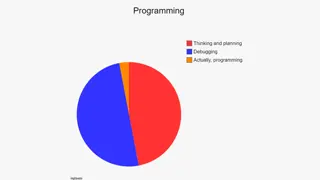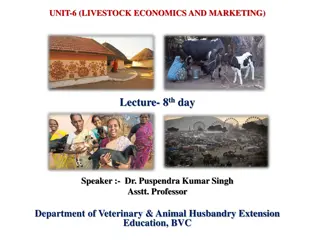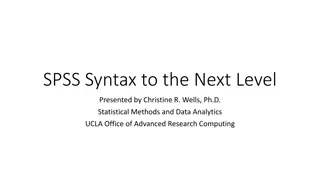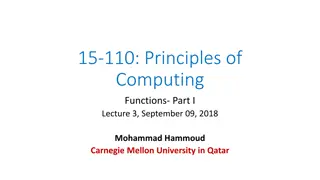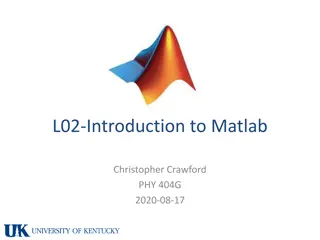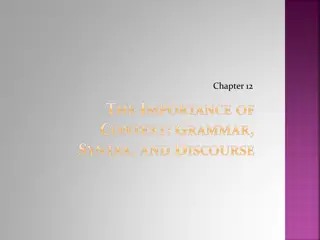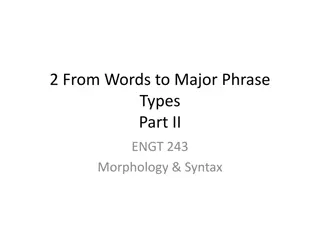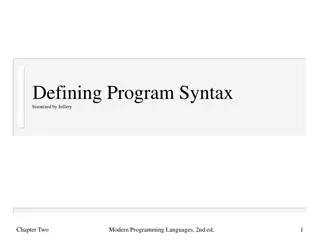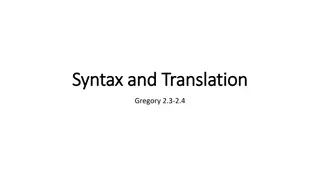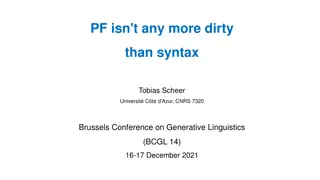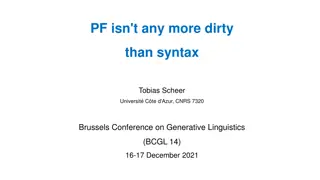Debitive Nominalization in Moksha: Functions and Syntax
Intricacies of debitive nominalization in Moksha, focusing on its functions, syntax, and usage through detailed research findings and data analysis from fieldwork in Mordovia. Discover the categorization of derived nominals and delve into the unique characteristics of the Ma nominalization in Moksha dialects.
Download Presentation

Please find below an Image/Link to download the presentation.
The content on the website is provided AS IS for your information and personal use only. It may not be sold, licensed, or shared on other websites without obtaining consent from the author.If you encounter any issues during the download, it is possible that the publisher has removed the file from their server.
You are allowed to download the files provided on this website for personal or commercial use, subject to the condition that they are used lawfully. All files are the property of their respective owners.
The content on the website is provided AS IS for your information and personal use only. It may not be sold, licensed, or shared on other websites without obtaining consent from the author.
E N D
Presentation Transcript
DEBITIVE NOMINALIZATION IN MOKSHA MORDVIN Aigul Zakirova National Research University Higher School of Economics SOUL 2017 Budapest, 27-28 June
OUTLINE OF THIS TALK ma nominalization in Moksha and its functions (process nominal vs other types); the syntax of the different types of the ma nominalization; debitive construction with the ma nominalization; the syntax of the debitive construction: case marking and agreement; object marking and object agreement in the debitive construction
DATA USED fieldwork in Lesnoe Tsibaevo (Temnikovsky district, Republic of Mordovia) Moksha Mordvin, central dialect corpus of written texts from the local newspaper Mokshen Pravda http://www.mokshen-pr.ru/ literary Moksha language based on the central dialect. 199 instances of the debitive construction were extracted, translated into Russian and annotated manually.
CATEGORIZATION OF DERIVED NOMINALS [Comrie, Thompson 2007]: nouns derived by the process of nominalization may be the name of the activity or state designated by the verb or adjective, or may represent one of its arguments . Name of activity or state: action/state nouns (also called process nominals [Grimshaw 1990]); Name of an argument: -agentive nouns; -instrumental nouns; -manner nouns; -locative nouns; -objective nouns (also called result nominals [Grimshaw 1990]); -reason nouns.
THE MA NOMINALIZATION IN MOKSHA Name of activity or state: action/state nouns (process nominals [Grimshaw 1990]); Name of an argument: -agentive nouns; -instrumental nouns; -manner nouns; -locative nouns; -objective nouns (result nominals [Grimshaw 1990]); -reason nouns; +patient nominalization (not objective/result)
PROCESS VS PATIENT NOMINALIZATION
PROCESS NOMINALIZATION The ma nominalization may denote a process, a fact or a proposition Arguments of the verb are expressed as dependents in an NP (double-possessive type in terms of [Koptjevskaja-Tamm 1993]): (1)s ora-t lad-DEF.SG.GEN song-GEN sing-NZR-3SG.POSS.SG the lad s singing a song mora-n mora-ma-c The process nominalization exhibits both nominal and verbal properties.
VERBAL PROPERTIES OF THE PROCESS NOMINALIZATION The ma nominalization can adjoin markers of some verbal categories: aspect and voice Aspectual marker on the nominalization sometimes obligatory: put'k-s'- ma-c/ *put'k- ma-c (2) vet -t water-DEF.SG.GEN drip-FREQ-NZR-3SG.POSS.SG drip-NZR-3SG.POSS.SG mol -s kaft minuta-t go-PST.3.SG two minute-PL The dripping of the water lasted for two minutes
VERBAL PROPERTIES OF THE PROCESS NOMINALIZATION The ma nominalization can be modified by adverbs and adverbials (which according to [Alexiadou 2001] is due to the presence of the verbal projections AspP and vP. (3) son p k very k n r t -f- l gladden-PTCP.RES-PQP.SG often-EL s id -st s r vn vanij -s competition-IN he s s k- ma-t i win-NZR-DEF.SG.DAT He was glad that he often won in competitions .
NOMINAL PROPERTIES OF THE PROCESS NOMINALIZATION The process nominalization inflects for all the nominal categories: case, number, definiteness, possessiveness. Apart from adverbs, it can also be modified by adjectives: (4) vi k / vi k-st tej -nz mora-ma-s mi a-nda-j strong strong-EL sing-NZR-DEF PRON.DAT-POSS.3SG disturb-IPVF-NPST.3SG Loud singing will disturb him/ her.
PATIENT NOMINALIZATION mus k- ma-z (5) mon I.OBL be-NPST.3.SG wash-NZR-1SG.POSS.SG I have laundry to wash (not yet washed) . ul -i The ma nominalization in (5) denotes an object that has to be V-ed . I will call it a patient nominalization. Whereas a result nominalization denotes the output of the event that comes into being after the event (i.e. a collection is something that starts to exist after the event of collecting), the participant of the situation denoted by a patient nominalization may already exist before the event.
NOMINAL PROPERTIES OF THE PATIENT NOMINALIZATION The patient nominalization inflects for the nominal categories of case, number, definiteness and possessiveness: (6) mus k- ma-n wash-NZR-POSS.1SG.PL things that should be washed . Patient nominalization can also be modified by adjectives: (7) k l g ma u - ma-z loved my loved one I should wait for . wait-NZR-POSS.1SG.SG
VERBAL PROPERTIES OF THE PATIENT NOMINALIZATION In formal terms [Grimshaw 1990], result nominalizations usually do not have internal structure. This is also true for the patient nominalizations. Unlike process nominalizations, patient nominalizations cannot adjoin verbal markers and be modified by adverbs: so, vi kst mus k ma(z ) (quick-EL wash-NZR- POSS.1SG) cannot be interpreted as something that should be washed quickly .
SUMMARY Process nominalizations in Moksha exhibit both nominal and verbal properties: nominal inflection and adjectival modification; some verbal categories and adverbial modification. Patient nominalizations denote an object that has to be V-ed so it has some modal flavor. They do not show verbal properties.
DEBITIVE CONSTRUCTION The ma form can be used as a predicate to convey the meaning of necessity. It is often used to provide instructions: (8)kaft ast-t mel j r -n s ej- nd - ma-t pr -s pez - ma two hour-ABL after hair-DEF.PL comb-IPFV-NZR-PL head-DEF wash-NZR Two hours later one should comb one s hair and wash it. I will call this usage of the ma form a debitive construction. In (8) we observe nominative marking of the patients j r -n and pr -s and agreement of the ma form with the plural patient of the verb s ej nd ms comb . In some early papers (Chudajeva 1953, Bubrikh 1953) the debitive construction was analyzed as an equative construction X is Y, where X = j r -n hair and Y = s ej nd mat combings
EQUATIVE ANALYSIS If we presume that Y stands not for the process nominalization but for the patient nominalization ( the object that should be V-ed ), the meaning of the resulting debitive construction is quite compositional: (9) kaft ast-t mel j r -n s ej- nd - ma-t pr -s pez - ma two hour-ABL after hair-DEF.PL comb-IPFV-NZR-PL head-DEF wash-NZR lit. The hair is what should be combed and the head is what should we washed
AGAINST THE EQUATIVE ANALYSIS However, there are some obstacles against this equative analysis in synchrony. The ma form in predicative position does not adjoin nominal morphology: (10) mon -d ej -n I.OBL-PRON.DAT-POSS.1SG u -ma / *u -ma-z / wait-NZR n i-ng still *u -ma-c kuvat for_a_long_time wait-NZR-POSS.1SG wait-NZR-POSS.3SG I still have to wait for a long time
AGAINST THE EQUATIVE ANALYSIS No adjectival modification is possible: *kuvak u -ma-t? (11) ton kuvat / you for_a_long_time long wait-NZR-NPST.2.SG Do I have to wait for you for a long time?
AGAINST THE EQUATIVE ANALYSIS In reference to past or future there is no copula: (12) *vas -n d i Vasya-DAT Intended: Vasya had to wait for his friend. ul -s be-PST u -ma wait-NZR jalga-c friend-3SG.POSS.SG Compare a true nominal predication: (13) mon ul - n be-PST.1SG doctor I was a doctor. vra I
DIFFERENTIAL OBJECT MARKING IN THE DEBITIVE CONSTRUCTION
DOM IN FINITE CLAUSES First, consider the DOM in finite clauses The case of the direct object depends on its referential status and other discourse properties, agreement depends on the case marking of the DO: DEFINITENESS CASE AGREEMENT INDEFINITE NON-MARKED NO DEFINITE GEN.DEF YES DEF CASE AGREEMENT
SUBJECT MARKING IN DEBITIVE CONSTRUCTION In the debitive construction the subject is in Dative: (14) s ora-n -t i luv -ma t kn iga-t guy-DIM-DEF.SG.DAT read-NZR this book-DEF.SG.GEN The boy has to read this book. However, in most cases (175/199) the subject is omitted.
OBJECT MARKING IN DEBITIVE CONSTRUCTION The object in the debitive construction is marked by NOM (not attested in finite clauses DOM), GEN.DEF or NON-MARKED NOM.DEF: (15) kaft ast-t mel j r -n s ej- nd - ma-t pr -s pez - ma two hour-ABL after hair-DEF.PL comb-IPFV-NZR-PL head-DEF wash-NZR Two hours later one should comb one s hair and wash it. GEN.DEF: (16) s ora-n -t i luv -ma t kn iga-t guy-DIM-DEF.SG.DAT read-NZR this book-DEF.SG.GEN The boy has to read this book.
CASE MARKING IN DEBITIVE CONSTRUCTION NON-MARKED: (17) mon -d ej -n mora-ma mora I.OBL-PRON.DAT-POSS.1SG sing-NZR song I have to sing a song . Question 1: what are the factors influencing the choice between NOM and ACC?
CHOISE OF THE CASE MARKING IN THE DEBITIVE CONSTRUCTION On the corpus of 199 instances of the debitive construction I tried to find a correlation between the case marking and -animacy; -linear position; -number of the object NP. The chi-square test was conducted. None of these hypotheses worked out.
OBJECT AGREEMENT IN THE DEBITIVE CONSTRUCTION Here the definiteness is important: definite NPs always trigger agreement with the ma form. (5) mon -d ej -n *mora-ma/ mora-ma-t mora-t n I.OBL-PRON.DAT-POSS.1SG sing-NZR/ sing-NZR-PL song-DEF.PL I have to sing the songs . However, unlike in finite clauses, the agreement is ALWAYS POSSIBLE (6) mon -d ej -n mora-ma/ mora-ma-t mora-t I.OBL-PRON.DAT-POSS.1SG sing-NZR/ sing-NZR-PL song-PL 'I have to sing songs'.
AGREEMENT IN THE DEBITIVE CONSTRUCTION On the same corpus of 199 instances of the debitive construction we tried to find a correlation between the agreement and -definiteness; -linear position; -case marking. The chi-square test was conducted.
AGREEMENT ~ DEFINITENESS NO AGREEMENT AGREEMENT INDEF 17 2 DEF 2 31 POSS 1 5 2 = 38.075, the result is statistically significant, p < 0.01 So there exists a correlation between the definiteness of the object NP and agreement morphology on the ma form.
AGREEMENT ~ CASE MARKING NO AGREEMENT AGREEMENT NON-MARKED 15 1 GENITIVE 2 9 NOMINATIVE 0 28 2 = 42.947, the result is statistically significant, p < 0.01 So there exists a correlation between the case marking of the object NP and agreement morphology on the ma form.
AGREEMENT ~ LINEAR POSITION NO AGREEMENT AGREEMENT OV 3 22 VO 18 18 2 = 9.438, the result is statistically significant, p < 0.01 So there exists a correlation between the linear position of the object NP and the ma form and agreement morphology on the ma form.
AGREEMENT IN THE DEBITIVE CONSTRUCTION The chi-square test shows that the factors that enhance the probability of the object agreement are: - a definite NP; - nominative case; - the linear position of the DP before the verb.
CONCLUSION I believe in the diachronic reality of the equative analysis proposed by [Bubrikh 1953] and [Chudaeva 1953]. However, in the present-day Moksha we see that the form that used to be a nominalization now shows only verbal properties and develops object agreement which is somewhat similar to the finite verb s object agreement: Finite verb s object agreement: -DEFINITENESS Debitive construction s object agreement: -DEFINITENESS -LINEAR POSITION BEFORE VERB -NOMINATIVE MARKING OF THE DIRECT OBJECT
SOURCES Alexiadou A. Functional structure in nominals: nominalization and ergativity. John Benjamins Publishing, 2001. . 42. Bubrikh D.V. Istoricheskaya grammatika erzyanskogo yazyka. The historical grammar of Erzya. Saransk, 1953 Chudajeva O.I. Vyrazheniye glagolnosti m-ovymi imenami deystviya v moksha-mordovskom yazyke. The expression of verbal properties by -m- action nominals in Moksha Mordvin. Saransk, 1953 Comrie B., Thompson S. A. Lexical nominalization //Language Typology and Syntactic Description vol. III: Grammatical Categories and the Lexicon. Cambridge University Press, 2007. . 334-381. Grimshaw J. Argument structure. the MIT Press, 1990. Koptjevskaja-Tamm M. Nominalizations. Routledge, 2002.



